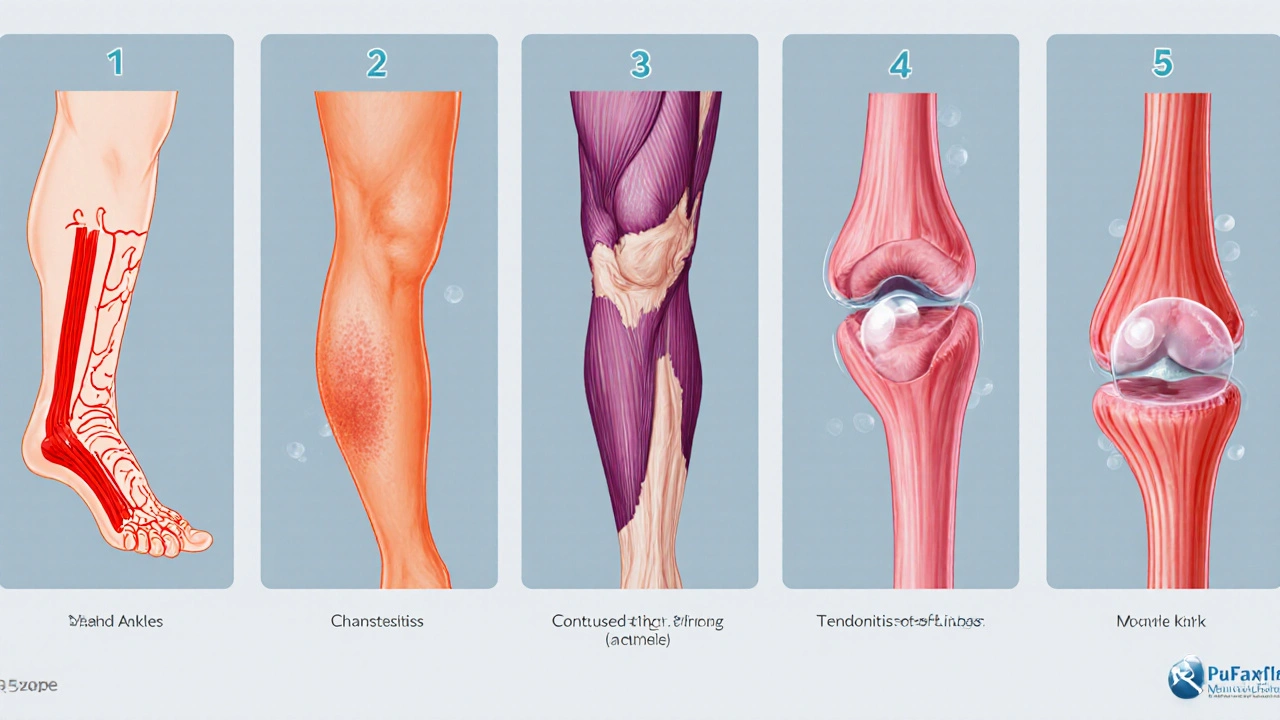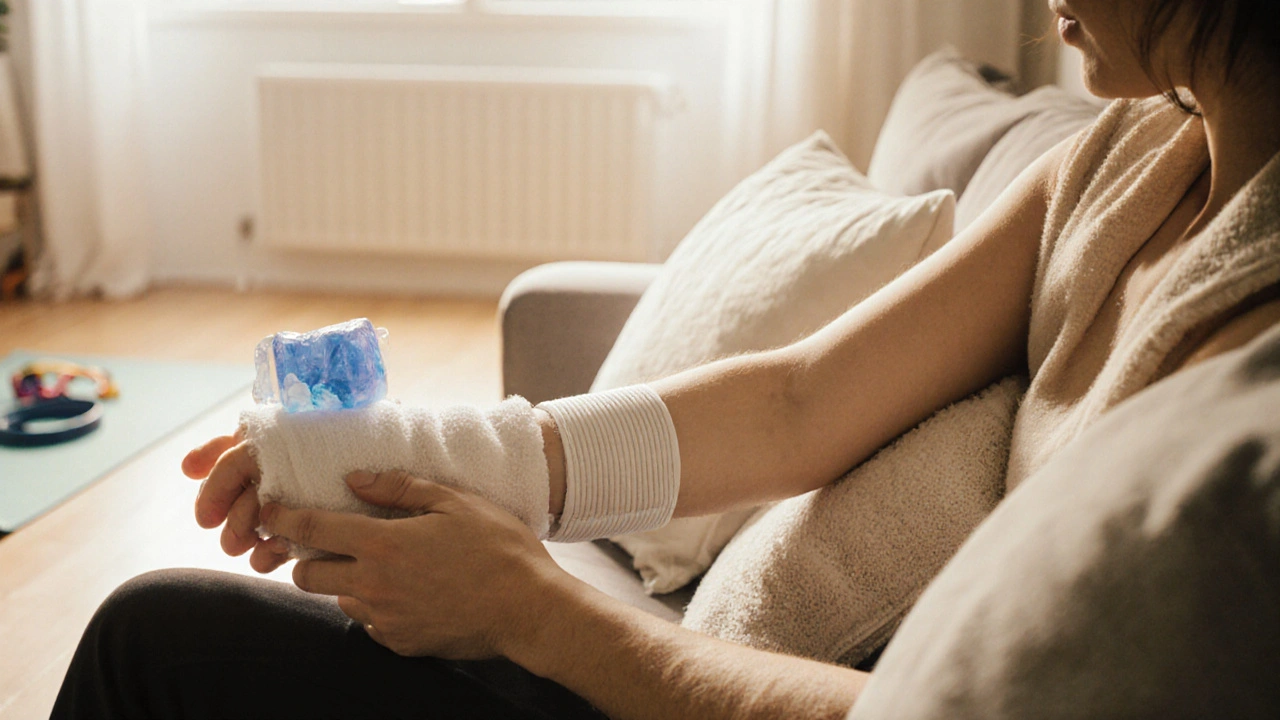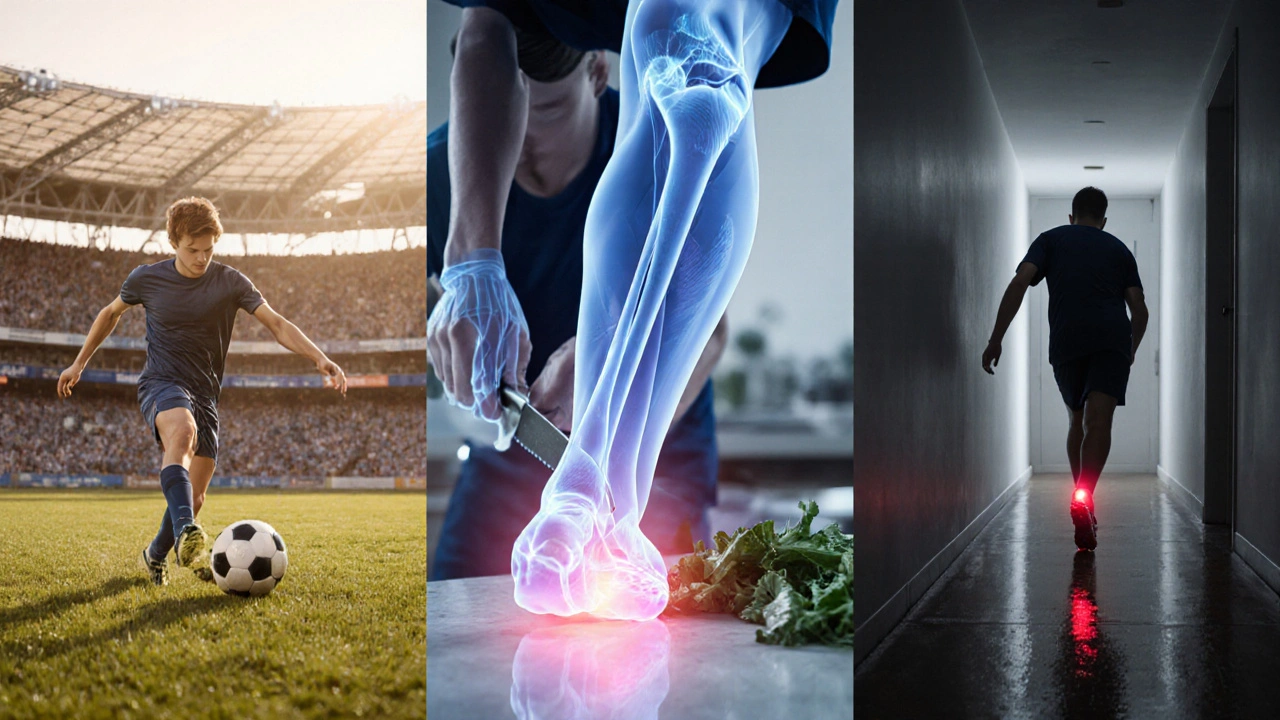Soft Tissue Injury Estimator
Quick Assessment
Answer these questions to estimate your injury type and recovery timeline
When your body takes a hit - whether on the soccer field, in the kitchen, or simply by slipping on a wet floor - the damage often isn’t to bone but to the softer structures that hold you together. Soft tissue injuries are a collection of damage to muscles, tendons, ligaments, fascia and other connective tissue. They range from a mild bruise to a torn ligament, and each type demands a slightly different approach to care.
What Are Soft Tissue Injuries?
Soft tissue refers to any tissue in the body that isn’t bone or organ. That includes muscles, tendons, ligaments, fascia, cartilage, and the fluid‑filled bursae that cushion joints. When any of these structures stretch, tear, or bruise, you get a soft tissue injury.
Common Types: Sprains, Strains, Contusions
A sprain a stretch or tear of a ligament, the fibrous band that connects bone to bone typically occurs when a joint is forced beyond its normal range, like twisting an ankle on uneven ground. Look for pain, swelling, and a feeling that the joint is unstable.
A strain an overstretch or tear of muscle fibers or the tendons that attach muscle to bone often results from lifting something heavy or sprinting suddenly. The hallmark signs are a sharp pull, muscle weakness, and sometimes a knot‑like lump where the fibers have torn.
A contusion commonly known as a bruise, is damage to blood vessels under the skin caused by a blunt impact. You’ll see discoloration, tenderness, and swelling, but the deeper structures usually stay intact.
Overuse Injuries: Tendonitis & Bursitis
Tendonitis inflammation of a tendon from repetitive stress shows up as a dull ache that worsens with activity and eases with rest. Common sites include the elbow (tennis elbow) and the Achilles tendon.
Bursitis inflammation of the small fluid‑filled sacs (bursae) that cushion joints often follows repetitive friction, such as frequent kneeling or leaning on elbows. It feels like a localized, hot swelling that hurts when you move the joint.

More Severe Tears: Ligament & Muscle Tears
A ligament tear a partial or complete rupture of a ligament can happen during high‑impact sports or accidents. You may hear a pop, experience immediate instability, and notice a sizable gap in the joint’s range of motion.
A muscle tear a rupture of muscle fibers, ranging from a minor strain to a full‑thickness break often produces a sudden sharp pain, a visible dent in the muscle, and a loss of strength.
How to Diagnose and When to Seek Care
- **Self‑assessment** - Check for swelling, bruising, loss of function, and pain intensity on a 0‑10 scale. If the pain is above 5 or you can’t bear weight, professional evaluation is wise.
- **Physical exam** - A clinician will test range of motion, stability, and strength to pinpoint the injured structure.
- **Imaging** - X‑rays rule out bone fractures; ultrasound or MRI visualizes soft‑tissue tears and inflammation.
Prompt diagnosis helps you avoid chronic issues like joint stiffness or recurring pain.
First‑Aid Steps and Rehab Basics
- Protect the injured area - avoid weight‑bearing or activities that aggravate pain.
- Rest - give the tissue 48‑72 hours of limited movement.
- Ice - apply a cold pack for 15‑20 minutes, three to four times daily, to reduce swelling.
- Compression - use an elastic bandage to limit fluid buildup, but not so tight it cuts circulation.
- Elevation - keep the limb above heart level when possible.
- After the acute phase, start gentle range‑of‑motion exercises and gradually introduce strength training under guidance.

Prevention Tips for Everyday Life
- Warm‑up before exercise - dynamic stretches increase blood flow to muscles and tendons.
- Use proper technique - whether lifting boxes or swinging a racket, correct form distributes stress evenly.
- Strengthen supporting muscles - balanced strength reduces strain on ligaments and tendons.
- Wear appropriate footwear - good arch support and grip prevent ankle sprains.
- Take regular breaks during repetitive tasks - short micro‑breaks lower the risk of tendonitis and bursitis.
Quick Comparison of Common Soft Tissue Injuries
| Injury Type | Common Site | Typical Cause | Main Symptom | Healing Time |
|---|---|---|---|---|
| Sprain | Ankle, wrist | Twist or impact | Swelling, instability | 2‑6 weeks |
| Strain | Hamstring, lower back | Overstretch, sudden lift | Sharp pain, muscle weakness | 1‑4 weeks |
| Contusion | Any muscle | Blunt blow | Bruising, tenderness | 1‑2 weeks |
| Tendonitis | Elbow, Achilles | Repetitive motion | Dull ache, worsens with use | 3‑12 weeks (depends on load) |
| Bursitis | Shoulder, knee | Prolonged pressure | Hot swelling, limited motion | 2‑8 weeks |
Frequently Asked Questions
Frequently Asked Questions
How can I tell if an injury is a sprain or a strain?
A sprain involves a ligament (bone‑to‑bone connector) and usually shows joint swelling and a feeling of looseness. A strain affects muscle or tendon and feels like a pulled muscle with localized tightness. Checking which structure hurts - joint versus muscle belly - helps you differentiate.
Is it safe to keep moving after a contusion?
Mild contusions can tolerate gentle range‑of‑motion exercises after the first 24‑48 hours. If pain spikes or you notice increased swelling, back off and apply ice. Always listen to your body.
When should I get an MRI for a soft tissue injury?
If you have severe pain, loss of function, or a suspected full‑thickness tear that isn’t improving after a week of proper care, an MRI can show the exact extent of muscle, tendon or ligament damage.
Can tendonitis become chronic?
Yes. Repeated stress without adequate rest, poor technique, or underlying biomechanical issues can turn acute tendonitis into a chronic condition that may need physical therapy or, in rare cases, surgery.
What home remedies help reduce swelling fast?
The R.I.C.E. protocol works best: Rest, Ice (15‑20 minutes every 2‑3 hours), Compression with a breathable bandage, and Elevation above heart level. Keeping the injured part still and hydrated also supports recovery.









Soft tissue injuries are nothing but an overblown excuse for poor training practices!!! Anyone still relying on the R.I.C.E. protocol is living in the past!!! Embrace proper conditioning and stop hiding behind bruises!!!
Absolutely, taking care of those muscles, tendons, and ligaments is crucial!!! The R.I.C.E. steps provide a solid foundation, but pairing them with gentle mobility work can speed recovery!!! Keep the community informed and support one another!!!
The protocol works well when combined with gradual stretching and proper hydration. It’s important to monitor swelling and seek professional advice if pain persists.
Rest, ice, and light movement get you back on the field fast.
Your body is a resilient machine, and with the right care it bounces back like a champion!!! Celebrate every small gain and stay motivated throughout the rehab journey!!!
The standard care advice often overlooks the need for early active rehab, which can prevent stiffness.
Staying positive and moving slowly really makes a difference in healing.
Healing is a balance between rest and gentle challenge; too much of either stalls progress.
The manuscript attempts a simplistic glorification of the R.I.C.E. protocol, ignoring the nuanced biomechanics that dictate true recovery.
It fails to acknowledge that premature immobilization can foster adhesions within the fascial planes.
Moreover, the categorical time frames presented disregard individual variability in tissue remodeling.
A thorough assessment must consider vascular supply, metabolic health, and prior injury history.
Neglecting these factors renders the advice dangerously generic.
The delineation between sprain and strain, while superficially accurate, omits the overlapping spectrum of partial ligamentous tears.
In clinical practice, MRI findings often reveal mixed-pathology cases that defy such neat classifications.
Patients are consequently misguided into self-diagnosing without professional guidance.
The article also overlooks the potential benefits of controlled loading, which accelerates collagen alignment.
Passive modalities alone, as suggested, may prolong atrophy and joint stiffness.
Rehabilitation protocols should be progressive, integrating proprioceptive drills from the earliest feasible stage.
Ignoring neurophysiological re‑education perpetuates compensatory movement patterns.
The writer's reliance on buzzwords diminishes the gravity of tailored therapeutic intervention.
Readers would benefit from a more evidence‑based discussion of adjunct therapies such as laser, ultrasound, and manual mobilization.
Until these shortcomings are addressed, the guide remains a superficial overview rather than a competent clinical tool.
Your thorough breakdown of each injury type is excellent; adding a quick reference chart helps readers apply the information efficiently.
Thank you for presenting a comprehensive overview of soft tissue pathology. The inclusion of both acute and overuse injuries provides a balanced perspective. I appreciate the clear articulation of the R.I.C.E. protocol alongside recommendations for progressive rehabilitation. Future updates might incorporate recent advances in tissue engineering and biologic adjuncts. Overall, this serves as a valuable educational resource for both clinicians and laypersons.